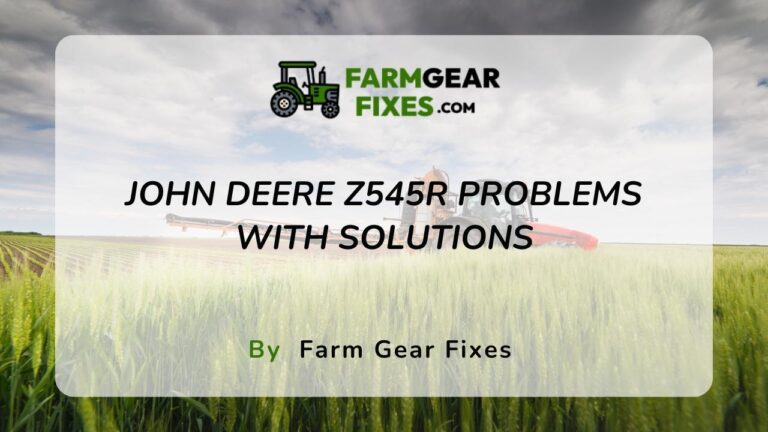6 Common John Deere 3039R Problems (Solutions Included)

Ever wonder what problems other John Deere 3039r owners face? This guide is here to help! We’ll shine a light on the most common issues, like engine trouble and hydraulic problems, and offer simple solutions to fix them yourself.
Whether you’re a farming pro or a brand new tractor owner, this guide will help you troubleshoot and fix any issues your 3039r throws your way, saving you time and frustration.
Engine Problems and Troubleshooting
To keep your John Deere 3039R running smoothly, it’s essential to be aware of common engine problems and their solutions. By understanding these issues, you can take proactive steps to prevent downtime and costly repairs.
1) Common Engine Problems
To ensure optimal performance of your John Deere 3039R, it’s crucial to address common engine problems promptly.
These issues may include overheating, excessive smoke, loss of power, and strange noises. Ignoring these symptoms can lead to significant damage and potentially costly repairs.
Step-by-Step Solutions
On the bright side, many of these common engine problems can be resolved with some simple troubleshooting steps.
By following a systematic approach, you can identify and address the root cause of the issue. Refer to the table below for step-by-step solutions to common engine problems:
| Common Engine Problem | Solution |
| Overheating | Check coolant levels and radiator for debris; inspect the water pump and thermostat. |
| Excessive Smoke | Inspect the air filter and turbocharger; check for fuel or oil leaks. |
| Loss of Power | Check fuel filter and exhaust system; inspect turbocharger and intercooler. |
| Strange Noises | Check for loose or damaged components; inspect the belts, pulleys, and bearings. |
Plus, performing regular maintenance such as changing the engine oil, fuel filter, and air filter can help prevent these common engine problems from occurring. By staying proactive and addressing any issues promptly, you can keep your John Deere 3039R running smoothly and efficiently.
Transmission and Drive Train Complications
Even the most reliable equipment like the John Deere 3039R can experience issues with its transmission and drive train. These parts are essential for the proper functioning of the tractor, and any complications in these areas can greatly hinder its performance.
2) Transmission Malfunctions
With regards to the transmission of the John Deere 3039R, some users have reported issues with gear shifting and slippage. In some cases, the tractor may struggle to shift into gear or may slip out of gear unexpectedly, causing a loss of power and control.
This can be extremely frustrating and potentially dangerous, especially when operating the tractor in challenging terrains or conditions.
To address these transmission malfunctions, it is important to regularly check and maintain the transmission fluid levels, as well as ensure that the transmission system is properly adjusted and lubricated.
3) Drive Train Problems and Fixes
The drive train of the John Deere 3039R is also prone to its own set of challenges. Common issues include excessive vibration, unusual noises, and loss of power when driving the tractor. The drive train, which includes the transmission, driveshaft, axles, and wheels, plays a crucial role in transferring power from the engine to the wheels.
The drive train must be properly aligned and balanced to ensure smooth and efficient operation. Regular inspections and maintenance of drive train components, such as greasing u-joints and checking for worn-out components, can help prevent these challenges and ensure optimal performance of the tractor.
Hydraulic System Difficulties
Keep your John Deere 3039R running smoothly by addressing any hydraulic system issues promptly. The hydraulic system is a crucial component of the tractor, and any difficulties with it can have a significant impact on its performance.
4) Identifying Hydraulic Issues
Hydraulic issues can manifest in a variety of ways, including slow or unresponsive hydraulic functions, erratic movements, or unusual noises coming from the hydraulic system.
It is important to carefully observe the tractor’s hydraulic system for any signs of trouble and to take note of any unusual behavior or performance.
5) Effective Hydraulic Solution
Difficulties with the hydraulic system can be addressed through several effective strategies. Regular maintenance and inspection of the hydraulic components can help to prevent issues from arising. Additionally, ensuring that the hydraulic fluid is at the proper level and in good condition is essential for the smooth operation of the system.
Issues with hydraulic hoses, fittings, or seals should be addressed promptly to prevent further damage to the system. It is also important to follow the manufacturer’s recommendations for the hydraulic fluid type and replacement schedule to avoid potential problems with the hydraulic system.
Electrical System Faults
Your John Deere 3039R may experience various electrical system faults, causing inconvenience and downtime. Understanding the diagnostic approaches and implementing repair and maintenance tips is crucial to address these issues effectively.
6) Diagnostic Approaches for Electrical Problems
Electrical problems in your John Deere 3039R can be caused by a variety of issues, including faulty wiring, damaged components, or battery-related issues.
When diagnosing electrical problems, it is important to systematically check the wiring, connections, and components for any visible damage or wear. Additionally, using diagnostic tools such as multimeters can help in identifying specific issues related to voltage, current, or resistance in the electrical system.
Repair and Maintenance Tips for Electrical Components
The electrical components of your John Deere 3039R require regular inspection and maintenance to ensure optimal performance. This includes keeping the wiring harness and connectors clean and free of debris, as well as checking for any signs of corrosion or damage.
Regularly testing the battery and charging system is also essential to prevent unexpected breakdowns. Perceiving the early signs of electrical problems, such as dimming lights or erratic behavior, is crucial for timely maintenance.
- Regular inspection and cleaning of wiring harness and connectors
- Testing battery and charging system regularly
System faults can be effectively managed by staying proactive and implementing regular maintenance practices for electrical components in your John Deere 3039R. These practices can minimize the risk of unexpected downtime and ensure the reliability of the electrical system in the long run.
Conclusion
Following this analysis of the common problems encountered with the John Deere 3039R, it is important to acknowledge that these issues often have straightforward solutions. By addressing the issue of the transmission not engaging, we can recommend checking the transmission fluid levels and adjusting the linkage if necessary.
Additionally, the overheating problem can often be resolved by checking for debris in the radiator and ensuring proper airflow to the engine. Lastly, the starting issues can often be traced back to the battery or starter, and addressing these components can often solve the problem. This information underscores the importance of regular maintenance and addressing issues promptly to keep the John Deere 3039R running smoothly.






